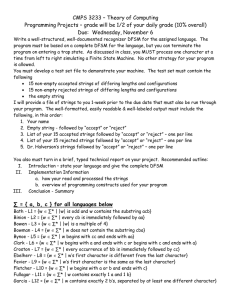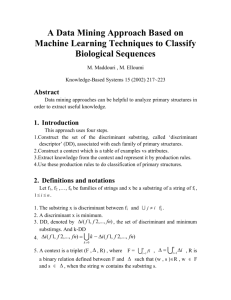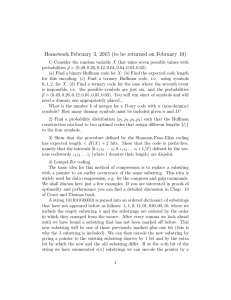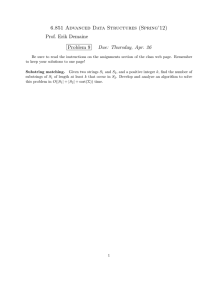6.857 Homework Problem Set 1 April 6, 2014
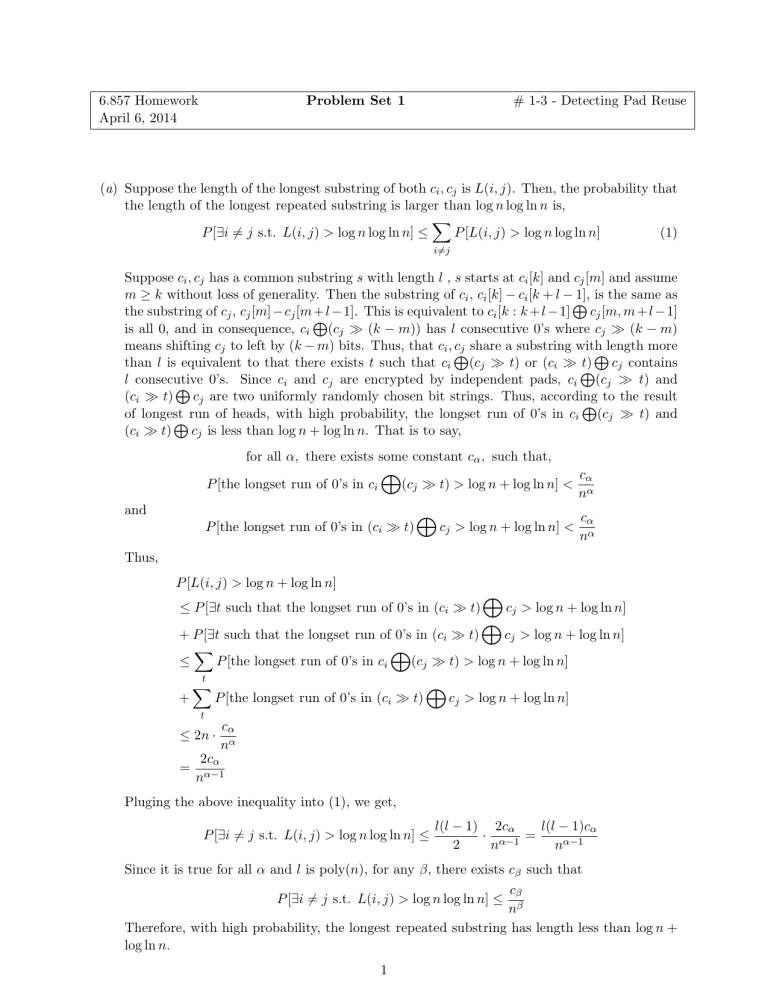
6.857
Homework
April 6, 2014
Problem Set 1 # 1-3 - Detecting Pad Reuse
( a ) Suppose the length of the longest substring of both c i
, c j is L ( i, j ).
Then, the probability that the length of the longest repeated substring is larger than log n log ln n is,
P [ ∃ i = j s.t.
L ( i, j ) > log n log ln n ] ≤ P [ L ( i, j ) > log n log ln n ] i = j
(1)
Suppose c i
, c j has a common substring s with length l , s starts at c i
[ k ] and c j
[ m ] and assume m ≥ k without loss of generality.
Then the substring of c i
, c i
[ k ] − c i
[ k + l − 1], is the same as the substring of c j
, c j
[ m ] − c j
[ m + l − 1].
This is equivalent to c i
[ k : k + l − 1] c j
[ m, m + l − 1] is all 0, and in consequence, c i
( c j
» ( k − m )) has l consecutive 0’s where c j
» ( k − m ) means shifting c j to left by ( k − m ) bits.
Thus, that c i
, c j share a substring with length more than l is equivalent to that there exists t such that c i
( c j
» t ) or ( c i
» t ) c j contains l consecutive 0’s.
Since c i and c j are encrypted by independent pads, c i
( c j
» t ) and
( c i
» t ) c j are two uniformly randomly chosen bit strings.
Thus, according to the result of longest run of heads, with high probability, the longset
( c i
» t ) c j is less than log n + log ln n .
That is to say, run of 0’s in c i
( c j
» t ) and and for all α, there exists some constant c
α
, such that,
P [the longset run of 0’s in c i
( c j
» t ) > log n + log ln n ] < c
α n α
P [the longset run of 0’s in ( c i
» t ) c j
> log n + log ln n ] < c
α n α
Thus,
P [ L ( i, j ) > log n + log ln n ]
≤ P [ ∃ t such that the longset run of 0’s in ( c i
» t ) c j
> log n + log ln n ]
+ P [ ∃ t such that the longset run of 0’s in ( c i
» t ) c j
> log n + log ln n ]
≤ P [the longset run of 0’s in c i
( c j
» t ) > log n + log ln n ] t
+ P [the longset run of 0’s in ( c i
» t ) c j
> log n + log ln n ] t
≤
=
2 n · c
α
2 c
α n α n α − 1
Pluging the above inequality into (1), we get,
P [ ∃ i = j s.t.
L ( i, j ) > log n log ln n ] ≤ l ( l − 1) 2 c
·
α
2 n α − 1
= l ( l − 1) c
α n α − 1
Since it is true for all α and l is poly( n ), for any β , there exists c
β such that
P [ ∃ i = j s.t.
L ( i, j ) > log n log ln n ] ≤ c
β n β
Therefore, with high probability, the longest repeated substring has length less than log n + log ln n .
1
( b ) If we interpret the result in bits, each English character is 8 bits, so the length of common substring will be 8 times the previous data, while log n will be essentially the same.
We can pick some data point to analyze, (5 , 1) will become (8 , 8), (10 , 2 .
5) will become (13 , 20), (15 , 5) will become (18 , 40), (20 , 8) will become (23 , 64).
We can easily see that as n gets bigger, the ratio of the length of longest run and log n is increasing, and will become bigger than 2 .
2 when n gets larger.
That is to say, the length of identical strings in English text will be much longer than random cyphertext.
This might because English text is not randomly chosen and there is some inference between words and sentences.
( c ) Concatenate all strings together while adding a special character $ to separate them.
For example, if we have 1011 and 0011, the concatenated string will be 1011$0011.
Denote the concatenated string by S , We claim that it we can find the longest repeated string in S , we can solve the problem.
According to the assumption, each pair of plaintexts does share a long common run of identical characters, and any pair of ciphertexts with independently chosen pads does not.
Thus, given poly(n) n-bit ciphertexts with total length N and one instance of pad reuse, the two ciphertexts using the same pad will have a common run of identical bits with length more than 2 .
2 log n
(according to the result of 2).
Thus, the longest repeated substring S should be longer than
2 .
2 log n .
Suppose we find the longest repeated substring S and the two identical substring is a , b .
If a and b is not overlapped, they should both contain $ or both not.
If they do contain
$, suppose a is divided to a
1
, a
2 identical and a
2
, b
2 must be by $ identical.
and
At b is least divided one to group b
1
, b
2 by
(suppose
$.
a
1
Then,
, b
1 a
1
, b
1 must be
) has length larger than 1 .
1 log n , so with high probability, the two ciphertexts containing a
1
, b
1 share the same key.
If both of them do not contain $, for the same reason, the two ciphertexts a and b should share the same key.
If a and b is ovelapped, they should not contain $, otherwise $ will appear twice within n bits.
So a, b are in the same ciphertext.
We claim that this will not happen with high probability.
Suppose the ciphertext is s and the distance between a, b is k .
Then, s and s » k share an identical substring at identical locations, which indicates, s L ( s » k ) contains a long run of
L 0’s.
Suppose s is the cyphertext of x encrypted by a key p , then s = x p .
Thus,
M s ( s » k ) = ( x p ) (( x p ) » k ) = x ( x » k ) p ( p » k )
Suppose p = p
1
. . . p n and m = p L ( p » k ) = m
1
. . . m n
, then m i
= p i
M p i − k
We can see that P [ m i
= 0 | p
1
, . . . , p i
− 1] = 0 .
5 for all i since p i is independent of all p j
, j < i .
Thus, m is uniformly distributed on all bit strings with length n .
According to part a), with high probability, the longest run of 0’s in ( x L ( x » k )) L m should be shorter than log n + log ln n , which indicates that a and b is overlapped and longer than 2 .
2 log n happens with very low probability.
Therefore, we have shown how to transfer the original problem into finding the longest re peated substring in S .
Finding the longest repeated substring in S is easy using suffix tree.
We just need to find the internal node which has longest path from the root, which can be done just by traversing the suffix tree.
Building the suffix tree for S takes
O
( N ) time, traversing it also takes O ( N ) time.
Thus, the whole algorithm takes
O
( N ) time.
2
MIT OpenCourseWare http://ocw.mit.edu
6.857 Network and Computer Security
Spring 20 1 4
For information about citing these materials or our Terms of Use, visit: http://ocw.mit.edu/terms .
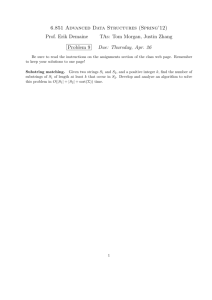

![Problem Wk.1.4.8: Substring [Optional]](http://s2.studylib.net/store/data/013337926_1-a8d9e314a142e3d0c4d9fe1b39539fba-300x300.png)
